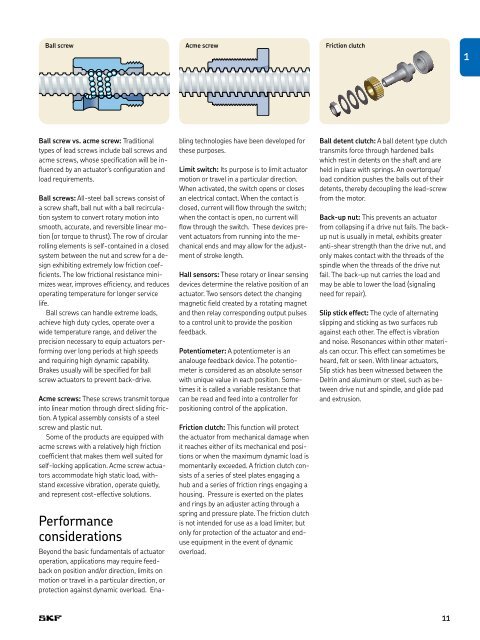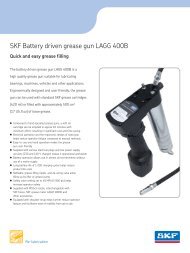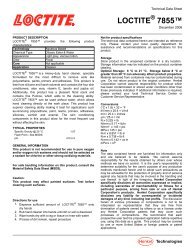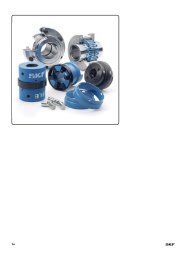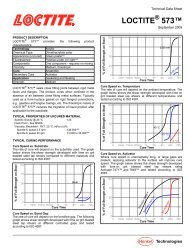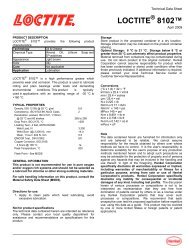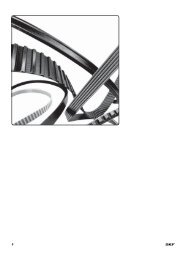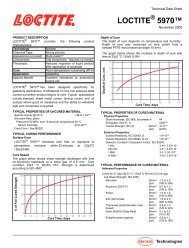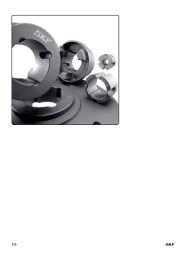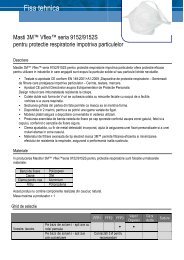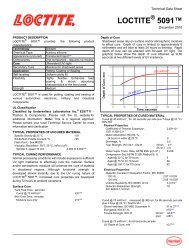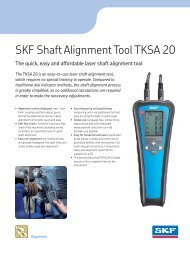PM CTP CAT M EA P 4 X 3 v01 | 2009-02-01 - Industrial GP - ro
PM CTP CAT M EA P 4 X 3 v01 | 2009-02-01 - Industrial GP - ro
PM CTP CAT M EA P 4 X 3 v01 | 2009-02-01 - Industrial GP - ro
- No tags were found...
You also want an ePaper? Increase the reach of your titles
YUMPU automatically turns print PDFs into web optimized ePapers that Google loves.
Ball screw<br />
Acme screw<br />
Friction clutch<br />
1<br />
Ball screw vs. acme screw: Traditional<br />
types of lead screws include ball screws and<br />
acme screws, whose specification will be influenced<br />
by an actuator’s configuration and<br />
load requirements.<br />
Ball screws: All-steel ball screws consist of<br />
a screw shaft, ball nut with a ball recirculation<br />
system to convert <strong>ro</strong>tary motion into<br />
smooth, accurate, and reversible linear motion<br />
(or torque to thrust). The <strong>ro</strong>w of circular<br />
<strong>ro</strong>lling elements is self-contained in a closed<br />
system between the nut and screw for a design<br />
exhibiting extremely low friction coefficients.<br />
The low frictional resistance minimizes<br />
wear, imp<strong>ro</strong>ves efficiency, and reduces<br />
operating temperature for longer service<br />
life.<br />
Ball screws can handle extreme loads,<br />
achieve high duty cycles, operate over a<br />
wide temperature range, and deliver the<br />
precision necessary to equip actuators performing<br />
over long periods at high speeds<br />
and requiring high dynamic capability.<br />
Brakes usually will be specified for ball<br />
screw actuators to prevent back-drive.<br />
Acme screws: These screws transmit torque<br />
into linear motion th<strong>ro</strong>ugh direct sliding friction.<br />
A typical assembly consists of a steel<br />
screw and plastic nut.<br />
Some of the p<strong>ro</strong>ducts are equipped with<br />
acme screws with a relatively high friction<br />
coefficient that makes them well suited for<br />
self-locking application. Acme screw actuators<br />
accommodate high static load, withstand<br />
excessive vibration, operate quietly,<br />
and represent cost-effective solutions.<br />
Performance<br />
considerations<br />
Beyond the basic fundamentals of actuator<br />
operation, applications may require feedback<br />
on position and/or direction, limits on<br />
motion or travel in a particular direction, or<br />
p<strong>ro</strong>tection against dynamic overload. Enabling<br />
technologies have been developed for<br />
these purposes.<br />
Limit switch: Its purpose is to limit actuator<br />
motion or travel in a particular direction.<br />
When activated, the switch opens or closes<br />
an electrical contact. When the contact is<br />
closed, current will flow th<strong>ro</strong>ugh the switch;<br />
when the contact is open, no current will<br />
flow th<strong>ro</strong>ugh the switch. These devices prevent<br />
actuators f<strong>ro</strong>m running into the mechanical<br />
ends and may allow for the adjustment<br />
of st<strong>ro</strong>ke length.<br />
Hall sensors: These <strong>ro</strong>tary or linear sensing<br />
devices determine the relative position of an<br />
actuator. Two sensors detect the changing<br />
magnetic field created by a <strong>ro</strong>tating magnet<br />
and then relay corresponding output pulses<br />
to a cont<strong>ro</strong>l unit to p<strong>ro</strong>vide the position<br />
feedback.<br />
Potentiometer: A potentiometer is an<br />
analouge feedback device. The potentiometer<br />
is considered as an absolute sensor<br />
with unique value in each position. Sometimes<br />
it is called a variable resistance that<br />
can be read and feed into a cont<strong>ro</strong>ller for<br />
positioning cont<strong>ro</strong>l of the application.<br />
Friction clutch: This function will p<strong>ro</strong>tect<br />
the actuator f<strong>ro</strong>m mechanical damage when<br />
it reaches either of its mechanical end positions<br />
or when the maximum dynamic load is<br />
momentarily exceeded. A friction clutch consists<br />
of a series of steel plates engaging a<br />
hub and a series of friction rings engaging a<br />
housing. Pressure is exerted on the plates<br />
and rings by an adjuster acting th<strong>ro</strong>ugh a<br />
spring and pressure plate. The friction clutch<br />
is not intended for use as a load limiter, but<br />
only for p<strong>ro</strong>tection of the actuator and enduse<br />
equipment in the event of dynamic<br />
overload.<br />
Ball detent clutch: A ball detent type clutch<br />
transmits force th<strong>ro</strong>ugh hardened balls<br />
which rest in detents on the shaft and are<br />
held in place with springs. An overtorque/<br />
load condition pushes the balls out of their<br />
detents, thereby decoupling the lead-screw<br />
f<strong>ro</strong>m the motor.<br />
Back-up nut: This prevents an actuator<br />
f<strong>ro</strong>m collapsing if a drive nut fails. The backup<br />
nut is usually in metal, exhibits greater<br />
anti-shear strength than the drive nut, and<br />
only makes contact with the threads of the<br />
spindle when the threads of the drive nut<br />
fail. The back-up nut carries the load and<br />
may be able to lower the load (signaling<br />
need for repair).<br />
Slip stick effect: The cycle of alternating<br />
slipping and sticking as two surfaces rub<br />
against each other. The effect is vibration<br />
and noise. Resonances within other materials<br />
can occur. This effect can sometimes be<br />
heard, felt or seen. With linear actuators,<br />
Slip stick has been witnessed between the<br />
Delrin and aluminum or steel, such as between<br />
drive nut and spindle, and glide pad<br />
and extrusion.<br />
11


